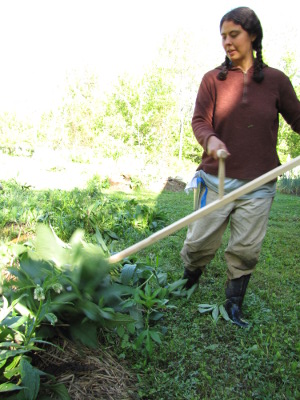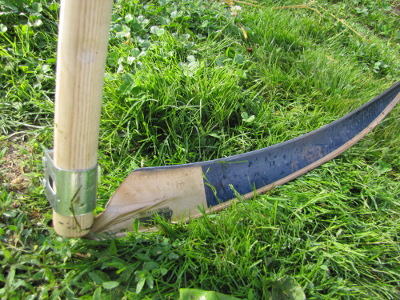
How to choose a scythe
 "Scythes are cool!" our
readers
admonish us every time we talk about our weedeater.
I used to be in love with the idea of scything once upon a time...and
then I was given a scythe.
"Scythes are cool!" our
readers
admonish us every time we talk about our weedeater.
I used to be in love with the idea of scything once upon a time...and
then I was given a scythe.
At the time, I didn't
know much about the tool, so I wasn't wise enough
to turn down the bulky American scythe and to save my pennies for a
quality Austrian scythe instead. I also trusted my father when he
told me that one size scythe fits all. That may be true if you're
a normal-sized man, but as a short woman, I spent all of my energy just
trying to keep the scythe blade from digging into the earth. I
gave up on the tool in disgust.
But then I stumbled
across Harvey
Ussery's scything page,
and was tempted once more. Ussery
explained that Austrian scythes cut with blades curved in three
dimensions, so they glide over the surface of the ground. In
contrast to the traditional American scythe blade --- which is stamped
out by a drop-forge press and has to be heavy to keep from breaking ---
Austrian blades are hand-forged by a blacksmith, so they are sharp,
light, and dent rather than shatter if you hit a rock. In fact, The
Scythe Book explains
that "over half the [Austrian scythe] blades
which begin the twenty-six stages of manufacture are rejected along the
way", which is why the blades are of such high quality (and cost so
much).
Then there's the handle,
known as a "snath" in scything circles.
Austrian snaths are typically very light, and both types of snath can
be fitted to your unique body. If you're an absolutely raw
beginner like me, you can order a scythe from The Scythe Supply
that's suited exactly to your proportions since you give them your
height, your handedness, the number of inches from ground to hip, and
your cubit (the distance from your elbow to your out-stretched middle
finger). The company will be sure the handles go in the right
places so you're not straining anything as you mow.
 While you're making your
decision, you'll also need to choose a kind and length of blade.
Your main choices are between bush/brush blades, which are short and
thick so they won't break when you whack at young saplings, and grass
blades, which are lighter and won't wear you out when you're cutting
softer plants. (A ditch blade is a bit of a hybrid, halfway
between the graceful grass blade and the hefty bush blade.) Grass
blades can be long or short, with longer blades being handy for
harvesting vast fields of wheat and shorter blades being more useful
when mowing small lawns with lots of edges. I think the raw
beginner could do worse than picking a middle of the road grass blade
--- I chose the 24 inch grass blade pictured here.
While you're making your
decision, you'll also need to choose a kind and length of blade.
Your main choices are between bush/brush blades, which are short and
thick so they won't break when you whack at young saplings, and grass
blades, which are lighter and won't wear you out when you're cutting
softer plants. (A ditch blade is a bit of a hybrid, halfway
between the graceful grass blade and the hefty bush blade.) Grass
blades can be long or short, with longer blades being handy for
harvesting vast fields of wheat and shorter blades being more useful
when mowing small lawns with lots of edges. I think the raw
beginner could do worse than picking a middle of the road grass blade
--- I chose the 24 inch grass blade pictured here.
With all of that in mind, I begged Mark to let me splurge on a hunk of
wood and metal, and he did. I'm here to tell you that the
difference between an American scythe that doesn't fit an an Austrian
scythe that does fit is like night and day. But this post is
already too long, so you'll have to wait to hear more about what
scything feels like and how to maintain a quality scythe blade in later
posts. If you want to learn more now, I highly recommend this
video my mom tracked down, which somehow manages to be inspiring and
hilarious all in a two minute time frame.
Want more in-depth information? Browse through our books.
Or explore more posts by date or by subject.
About us: Anna Hess and Mark Hamilton spent over a decade living self-sufficiently in the mountains of Virginia before moving north to start over from scratch in the foothills of Ohio. They've experimented with permaculture, no-till gardening, trailersteading, home-based microbusinesses and much more, writing about their adventures in both blogs and books.
Want to be notified when new comments are posted on this page? Click on the RSS button after you add a comment to subscribe to the comment feed, or simply check the box beside "email replies to me" while writing your comment.

In the early '70's I had a secluded mountain home on 77 acres mostly wooded but with some open places with an abundance of wild oats caused by seeding valleys nearby for cattle. I had horses and a couple of feeders so I needed a way to cut the oats and use it for feed. I bought an American scythe. In my ignorance I was lucky and the scythe with one minor adjustment fit me perfectly. What a joy it was to use. To me cutting the oats was the greatest dance I have ever experienced. The horses would come to the fence when they saw me with the scythe. I threshed and winnowed the oats for my breakfast and I have been disappointed with store bought oats since.
Recently I decided I needed another scythe and the search was on. This time I actually studied the scythe so I could buy one with confidence and competence. After searching for a while it came to me that on this half acre I really needed one to work in close quarters and around plants I really did not want to cut which meant that a regular scythe blade was to long. I finally decided on a long handled grass hook. When I was a kid we called these a "sickle". It has an Austrian blade of 12.5 inches and an American snath, I believe, of 44 inches. It works perfect. I have only cut myself twice, Once in the neck and once in the top of the head (don't ask), but since I didn't bleed to death I eventually learned to treat it with respect.
In the more open areas I swing it like a scythe and even with a short blade it will cut a lot of grass and weeds. The blade is magnificent.
Almost nobody does hand-forging any more these days, except for demonstration purposes. Most use a power hammer, because shaping steel is hard. The difference between open forging and stamping is mostly wether one uses an open die or an impression die, and there is nothing inherently low-quality about the latter.
On the contrary. Things like crankshafts and connecting rods for combustion enginges are usually stamped (die forged) because it is cheaper for large runs and because die forged parts have a significantly higher strength to weight ratio than cast or machined parts.
I suspect that even the "Fux" blades (made by schröckenfux) start out as stampings, because of the stamped markings on the tang. It it then probably finished in the end by cold hammering to take advantage of work hardening.
Besides, the quality has more to do with using modern alloys than by the mythical qualities of hand-forging. Before the invention of the Bessemer process, steelmaking was not a continuous high-quality process, to put it mildly! Forging was a way to literally hammer out the impurities.
And about the manufacturing process, if you have to reject half of your products in the course of processing, you're not doing a very good job! The end products might be high-quality, but the process quality sucks. Anyone who is in manufacturing could tell you that a 50% reject rate is not something to be proud of, but rather a reason for concern.
Oldfool --- My mom loves her hand sickle too. I may eventually try one --- it would probably make more sense for certain of my applications (like cutting back comfrey to take advantage of its dynamic accumulation). Try not to cut yourself on the neck and head!!!
Roland --- I think there's a big difference between a crankshaft and a scythe blade, though. The latter needs to be able to be kept extremely sharp, and at the same time merely dent when hit with something hard. That's why there's such a complex method of sharpening them, which I'll go into in a later post. Whatever the technical reason, I could definitely tell a huge difference between the high quality blade and the low quality blade.
Keeping an edge well and denting instead of breaking is not the contradiction that you seem to imply. It is a question of material, processing and geometry.
E.g. 5160 or 9260 spring steels are often used in creating modern knives and swords because they are good compromises between ductility and sharpness when properly (heat)treated. (Heat)treating is absolutely critical in determining the properties of a steel tool.
As for the influence of the sharpening method (like peening, which is essentially work hardening), see this hardness report on scythe blades. The reported hardness of the blades is about 45 Rockwell C, with not much of an increase over the width of the blade. The aforementioned 5160 can be hardened up to 60 Rockwell C. See this FAQ.
http://www.youtube.com/watch?v=gekhALWtZhQ
American scythes are great. Most of the disdain is initiated by the retailers who are pushing Euro scythes, which is ironic. Usually they can be obtained for next to nothing as well. The whole shabang for a Euro scythe and the peening jig etc from scythe supply is probably 250 dollars or so. I paid 10 for my American and can outmow a Euro. They are not used the same way, this is what reinforces the negative opinions of them. They are not swung in an arc like the euro is, attempting to cut like that will kick your butt. Once you get the technique down, the extra weight and bulk which the Euro pushers find so horrifying is actually very much advantageous. You can just pull the scythe through the swath and if its sharp it will cut with little effort. If you try that with a Euro you will feel like you are swinging a pie tin clamped to the end of a long stick.
Hello, Anna! I strongly suggest reading this guide with regard to American scythes:
http://lib.store.yahoo.net/lib/yhst-129988217023674/ScytheGuide1.pdf
The American pattern isn't for everyone, but easily 99.99% of all complaints people have with it are the result of misinformation and improper tuning and use. I own both American and European scythes and find myself using the American for virtually all of my mowing. They are heavier tools, yes, but perhaps the document will be of help when it comes to understanding why. Many snaths are, indeed, overbuilt, but they can be shaved down slimmer and the nib bands hammered to a smaller diameter so they grip tight again. Your problem with adjustment was probably due to not heating and adjusting the tang--one of the most common and fundamental mistakes folks make with American scythes. The tang angle is still much more shallow than with European scythes and their run is still more upward, but a blade with an unpitched tang can make awful unpleasant work!